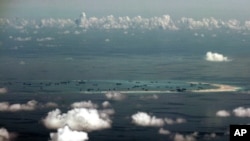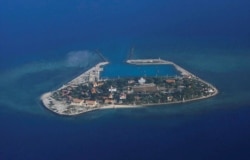Vietnam has placed military hardware over the past two years on islets that it controls in what some experts on the region say is an intention to deter any attacks from China, the dominant nation in disputes over the waterway.
The government in Hanoi, one of six claimants to all or parts of the resource-endowed South China Sea, has bulked up bunkers, coastal defenses and communications, according to a report by the Asia Maritime Transparency Initiative under the Washington D.C.-based Center for Strategic and International Studies.
“I think Vietnam wants to make sure it has some kind of second-strike capability, so make sure that it’s got at least some missile platforms on the islands that can range China’s bases,” initiative director Gregory Poling said.
Brunei, China, Malaysia, the Philippines, Taiwan and Vietnam claim all or parts of the sea that stretches from Hong Kong to the island of Borneo. The 3.5 million-square-kilometer waterway is prized for fisheries, shipping lanes and undersea fossil fuel reserves. Each nation holds features in the Spratly Island archipelago where the Vietnamese installations have been built.
China claims 90% of the sea based, it says, on historical usage records. The Beijing government, backed by the world’s third strongest armed forces, took a lead in the dispute about a decade ago by landfilling tiny islets and placing military equipment on some. Chinese naval drills and passage of vessels through the claims of other countries have prompted the United States to send warships.
Vietnam would take a No. 2 spot in defense of its islets after China following the latest fortifications. It has reclaimed about 1/20th of some 1,200 hectares of reclaimed land that China used in bulking up islets under its control.
Vietnam does not expect to win any conflict with China, nor is it considered likely to attack anyone else. It wants China to know that it could defend itself if attacked first, analysts in the region believe.
“It’s signaling to China that there’s a cost if you attack, (that) it’s not so easy as it was yesterday when the henhouse was unguarded, now we’ve got an ability to defend it a bit,” said Carl Thayer, emeritus professor at the University of New South Wales in Australia.
The two sides that have weathered centuries of border disputes, clashed at sea in 1974 and 1988, killing people both times. A boat ramming incident in 2014 sparked by placement of a Chinese oil rig in disputed waters led to deadly anti-China rioting in Vietnam.
Vietnam-held West Reef in the Spratly archipelago has seen “significant new construction,” the initiative website says. The website that cites satellite photos notes several coastal defense installations, administrative buildings, concrete pads and bunkers plus a tower structure that may be used for communications.
Another feature, Sin Cowe Island, received its own “significant upgrades” over the past two years, the website says. It points to construction of defensive installations along the coast and says the work began in 2019.
All 10 Vietnam-controlled islets have some kind of military facility, Poling said.
Newer installations improve coastal artillery to stop any amphibious landing by China, he said, and Vietnam hopes also to stop China from interfering with resupplies to Vietnamese-held islets as it has done with features claimed by the Philippines.
Vietnam's other Spratly features support radars as well, and the country hopes its missile platforms there could "range China's bases" if needed, Poling said.
“The Vietnamese government is worried about artificial reclamation by the Chinese government, so they also want to do something to beef up the defense capability at these islands,” said Nguyen Thanh Trung, Center for International Studies director at University of Social Sciences and Humanities, Ho Chi Minh City.
Vietnamese officials have not commented publicly on the new island hardware and the nation’s mass media say little about the subject, Nguyen said.
Hanoi wants to maintain a low-profile and emphasize self-defense, he added. If it builds up the islets to the levels that China has done, he said, other Southeast Asian claimants would reduce their support for Vietnam.
In China, the state-controlled Huanqiu.com news website said March 1 in response to the initiative’s findings that China’s “sovereignty” over the sea was “undisputed.”
“The Chinese side urges any nearby country with an existing dispute to use friendly bilateral dialogue in search of a solution,” the report says, citing the foreign ministry in Beijing.









